The Dell Venue 8 7000 Series Review
by Brandon Chester on March 12, 2015 8:00 AM EST- Posted in
- Tablets
- Dell
- Android
- Mobile
- Venue 8 7000
Software
It could be said that software has always been something of a pain point for Android tablets. However, before discussing the application situation which is out of Dell's control, it's worth talking about the software that comes on the Venue 8 itself. The first thing users will notice is that despite being a flagship device launching after the release of Android Lollipop, the Venue 8 still runs Android 4.4.4 KitKat. Dell has promised that there will be a future update to Lollipop, but no concrete time frame was given and so users could be waiting for quite some time.
Unfortunately, there are some parts of the KitKat interface that look quite dated. The Tron blue on sliders, window borders, and buttons had run its course long before it was replaced in Lollipop, and seeing it re-appear after using Lollipop for quite some time is jarring. Other areas like the keyboard also look dated and don't fit in well with any applications that have been updated to align with Google's Material Design principles. Thankfully, applications like the keyboard that have been moved over to Google Play can be updated and switched to their new Material Design interfaces. Unfortunately, functional issues aren't as easily addressed in this manner. An example is how the notification shade and quick toggles are segmented into separate areas, which feels downright archaic after using Lollipop.
Dell has not made a great number of modifications to Google's Android KitKat interface. The launcher and settings applications have been given a turquoise texture for their background which I actually consider to be more aesthetically pleasing than the old Tron blue gradient in the case of the settings application. If users are unhappy with Dell's changes, they'll be in a similar situation to the keyboard where they can simply download the Google Now Launcher from Google Play and have the same interface as any users who are running Lollipop.
The decoupling of many applications from Android has done a great deal to reduce issues with interface and feature fragmentation introduced by not having the latest OS updates. Unfortunately, core applications like Settings and sections of the interface like the status bar and notification shade are always reminders that your device is running an outdated version of Android, and so I hope Dell is able to ship a Lollipop update sooner rather than later.
As for preinstalled applications, there are a number of them, including several Dell branded applications like Dell Cast and My Dell. None of these apps can be uninstalled, and it's especially concerning because after the space taken up by the OS, storage formatting, and preinstalled applications, there's only 9.12GB free for the user to use. While this can be expanded via MicroSD, it's not a solution for installing apps, and installing just a few large AAA games will fill the Venue 8 up quickly. Of the preinstalled applications, I recommend immediately disabling McAfee Security and MaxxAudio.
In addition to these preinstalled apps, the initial setup for the Venue 8 presents you with the screen shown above. I'm completely okay with the idea of offering potentially useful applications to be optionally installed during the setup process, and I think every single preinstalled application that comes on top of the stock Android apps should be offered in the same manner, unless it's necessary to use a certain hardware feature.
The Application Situation
One of the primary criticisms of Android tablets over the years has always been that the library of applications that are actually optimized for large screen devices is small, with the number of iPad applications usually taken as the reference point. There are a number of factors that have contributed to this, and it's worth mentioning them before looking at the tablet application situation currently on Android.
One of the reasons that developers may feel less compelled to make applications with special tablet interfaces on Android is actually due to the fact that Android has application scaling in the first place. Unlike on the iPad where applications made only for the iPhone look pixelated and display in a window, applications on Android will scale to fill an entire tablet display. The fact that phone applications aren't essentially unusable on Android tablets can definitely be a factor in developers preferring to focus on adding new features and fixing bugs rather than creating a specialized interface.
Another issue that seems to seldom be discussed is the aspect ratio and orientation of Android tablets. Generally, Android tablets have used a 16:10 aspect ratio, and their native orientation has been portrait for 7 to 8 inch tablets, and landscape for larger ones. While the 16:10 aspect ratio is better for watching videos than the 4:3 aspect ratio used on a select few tablets, its advantages don't go far beyond that. It's more difficult to fit dual-pane interfaces onto the screen in portrait mode, and there's a lack of vertical space to work with in landscape mode. The more narrow screen profile makes it difficult to build a common interface for tablets that expands when put into landscape without having to change significantly from the portrait interface. It's no surprise that Google has moved to 4:3 with the Nexus 9, but by this point most applications simply use their phone interface which will have proportions that scale fairly well to 16:10 in portrait.
The third issue, and the one that I find to be the most significant and shocking is Google's own leadership in this space. During my time with the Venue 8, I actually found that the most poorly designed applications were ones made by Google. While I could find some third party applications like Flipboard and Skype that at least attempt to have good tablet interfaces, every Google application except for Gmail did not even attempt to present a suitable tablet interface.
Above you can see the Google Play application on the Venue 8 compared to its appearance on the Nexus 6. While the user with the Venue 8 has to carry around a significantly larger device, they're not getting much use out of it with regards to the amount of information they see on screen. This almost comically large interface exists throughout the Google Play application, as well as many of Google's other apps.
The Hangouts app is a good example of both the issues with the 16:10 aspect ratio in making tablet applications, as well a somewhat shocking lack of focus on Android tablet apps from Google. As you can see above, the Hangouts application on Android tablets is essentially an enlarged version of the phone application, with more conversations visible due to the size of the display.
The iOS application is completely different from its phone counterpart, with a segmented layout that allows the list of conversations to be seen alongside an open conversation. This is a common interface for messaging application on iPad, and it would be quite cramped if attempted on a 16:10 device in portrait mode. However, in landscape mode both tablets should be capable of displaying a segmented view, yet Google has done no such thing with the Android app and simply has it stretch out horizontally. It's honestly an embarrassing situation for what should be the prime examples for developers of how to do tablet apps correctly on Android.
However, as I said earlier, there are notable examples of popular apps that have embraced the ability of Android tablets to display much more information than smartphones. Flipboard is a good example. It shows more tiles than its smartphone counterpart in portrait, and has a special interface for landscape that doesn't even exist in the smartphone layout. While it doesn't show quite as much text on the tiles as the iPad app due to the limited number of vertical pixels when using a 16:10 display in landscape, it's still a great tablet application on Android and something I would point to as an example for other developers to look at.
The issues with tablet applications is not something that Dell or any other tablet vendor can control, but it's something that needs to be discussed so users are aware of what they're getting into. I honestly can't lay any of the blame with third party developers on Android either, because they've been put in a difficult position by the more narrow 16:10 aspect ratio of these devices, and have had absolutely no leadership from Google on how to make great apps. If Google can't be bothered to do it, I don't see how other developers can be expected to. My fear is that even with Google making improvements to apps like Gmail, that it may be far too late to get proper support from developers at this point.


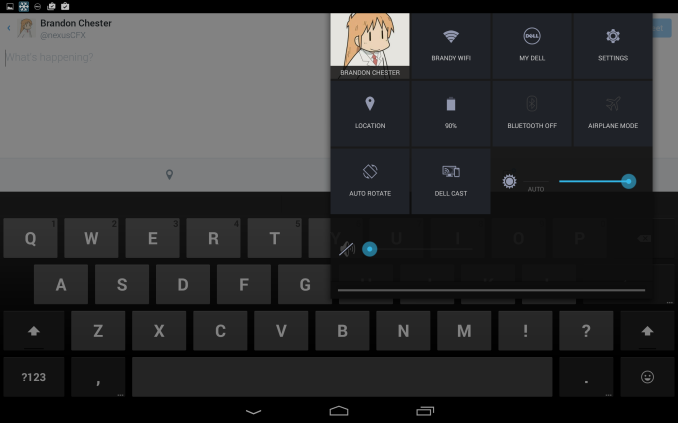
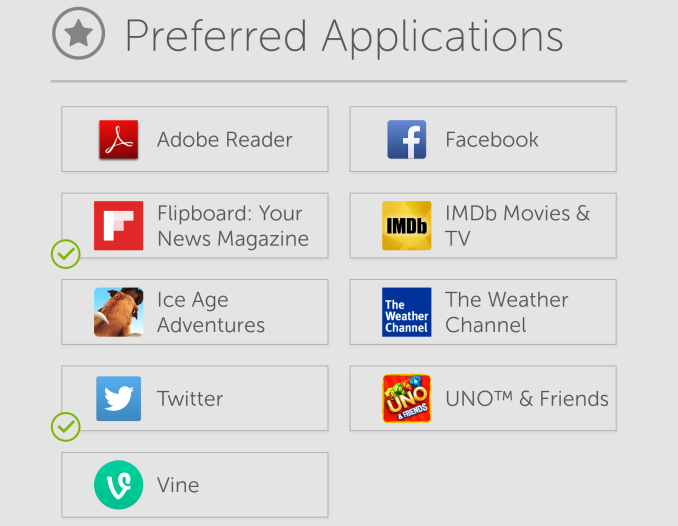
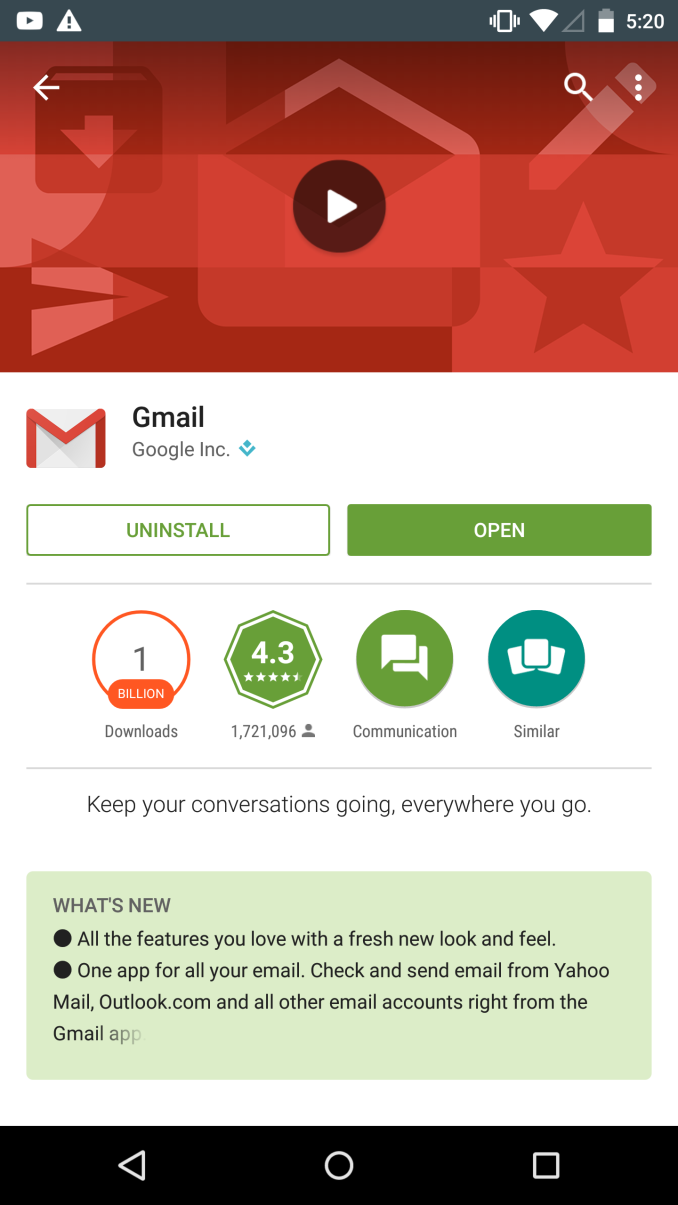
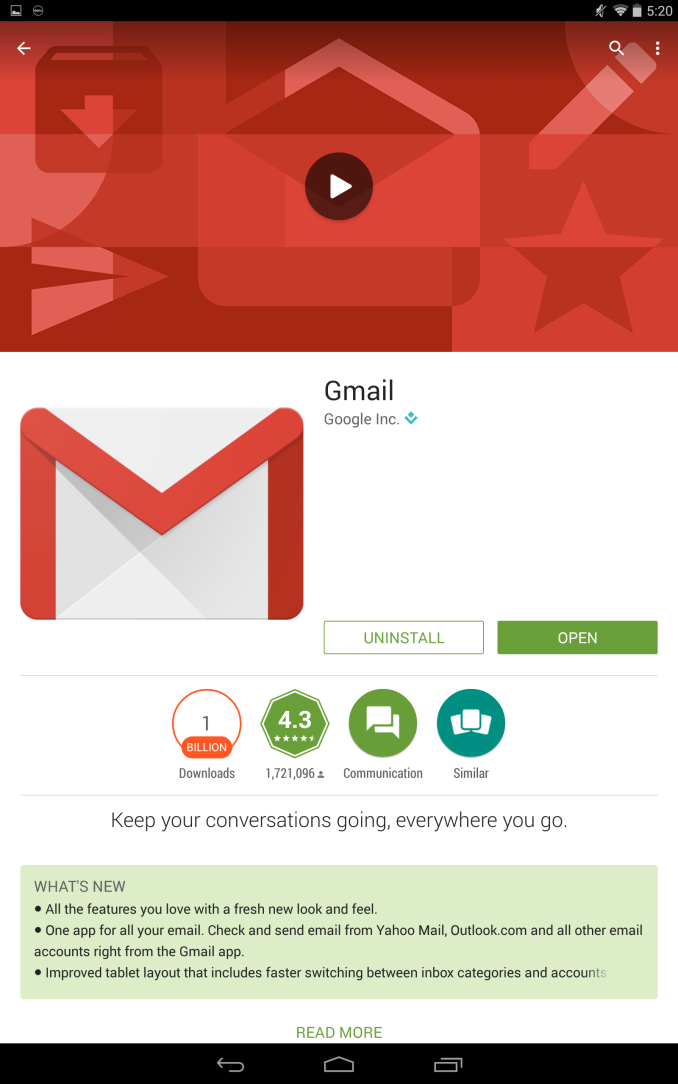
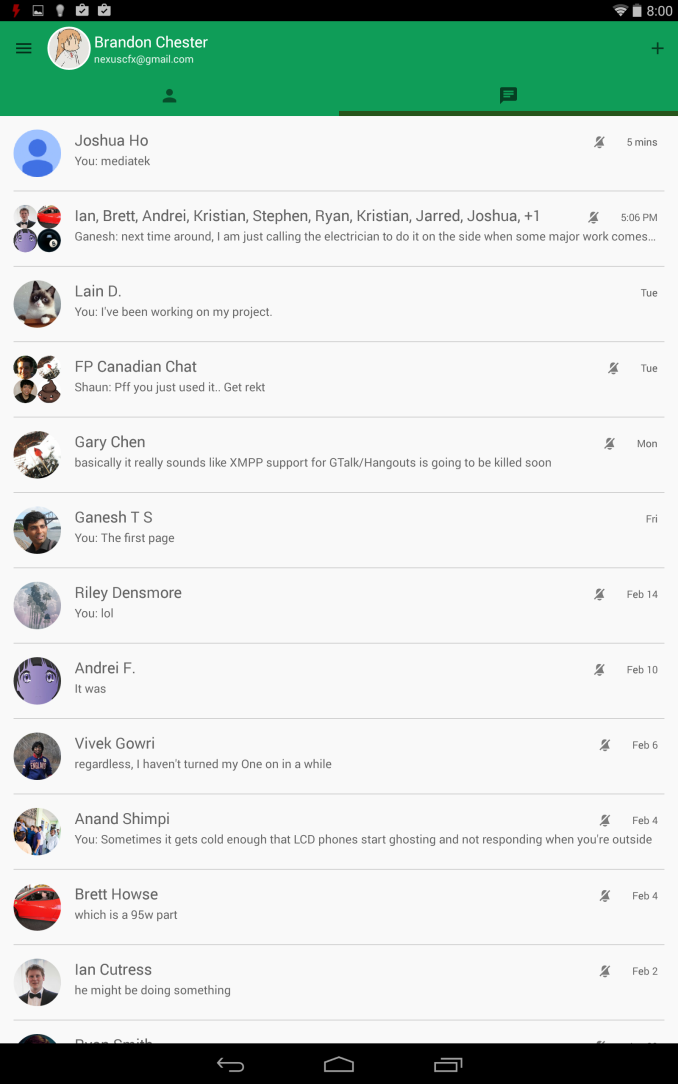
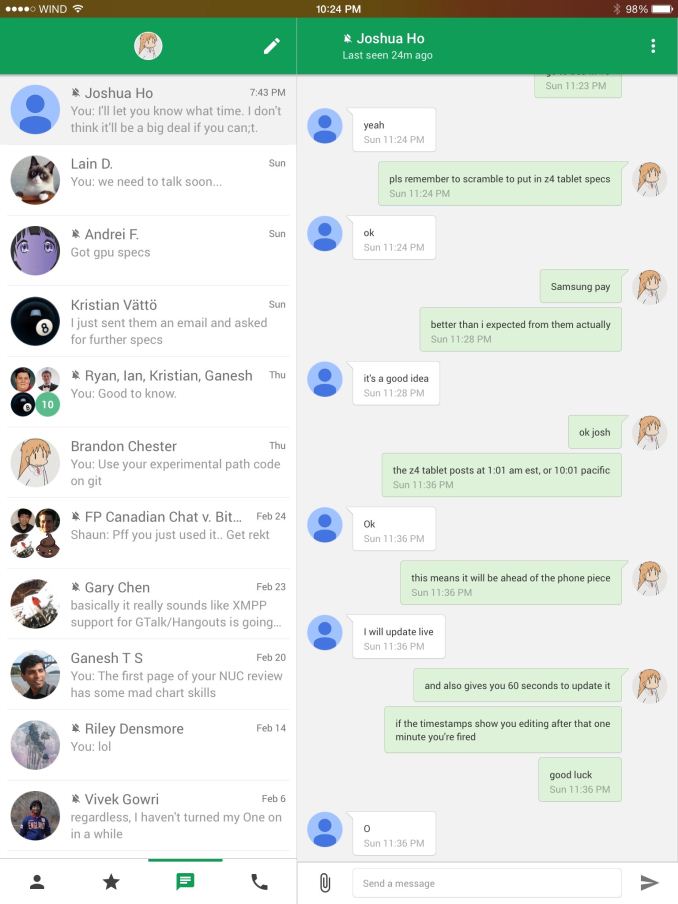
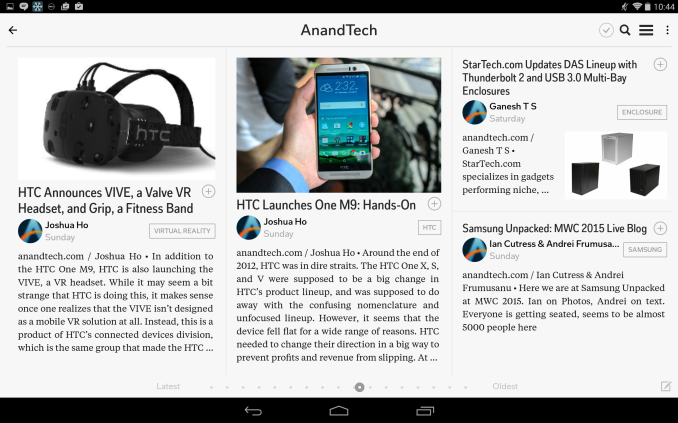








89 Comments
View All Comments
Sushisamurai - Sunday, March 15, 2015 - link
Yeah, this was a really well done review. Thoroughly enjoyed it even tho I'm not a dell fan.tipoo - Thursday, March 12, 2015 - link
My primary interest in this is that it has the same chip as in the Zenfone 2, I wonder how much it will have to scale back for a smartphone form factor. Seems like that could be the next budget champ, since it should be closer to the Snapdragon 800 than the 400.hrrmph - Thursday, March 12, 2015 - link
I find it less disconcerting that Dell made a WiFi only version that is being mistaken for a flagship tablet than the fact that it remains difficult to figure out from AT reviews whether there is an LTE version of any given tablet.For a flagship tablet review, this should be prominent in the Connectivity section, if not in the Introduction. Flagship tablets have everything but the kitchen sink thrown in - and that is the way it should be.
There is nothing wrong with the manufacturer making a WiFi only version. It is just that doing so will automatically make that version of the tablet a mid-range tablet. Maybe, upper mid-range - at best, if we are being charitable and they nailed everything else down perfectly.
4G LTE and GPS radios are mandatory for a tablet to be considered a true fully equipped flagship because it represents the peak level of equipage possible. Those who need it know why they need it...
...and AT should make it easier for us to figure it out... instead of having to sort through a pile of chaff to figure out if we are even interested in the article at hand. As it is, these type of muddled articles border on being clickbait.
If it were not for a helpful reader's comment, I wouldn't even know that Dell has produced LTE versions in this class of device.
In addition to asking whether Dell is interested in providing full flagship value, I'm finding myself asking the same of AT.
Brandon Chester - Thursday, March 12, 2015 - link
I apologize for not listing it in the chart on the first page. However, it was mentioned in the WiFi section. I've added it to the connectivity cell in the spec chart to make it easily accessible.FlyBri - Thursday, March 12, 2015 - link
@hrrmph -- I'm sorry, but you are sorely mistaken with your comment about a flagship tablet absolutely having to have a 4G LTE radio. Adding in a cell radio usually increases the cost of the tablet much more, and you can have the exact same tablet without it, and it's still considered flagship. So what are you saying is that an iPad Air 2 with a cell radio is a flagship device whereas the same iPad Air 2 without is not? That's just ridiculous. any iPad Air 2 is a flagship device -- period. Many tablets are used just as a media consumption device at home with WiFi. And as someone mentioned earlier, you can also many times use your phone as a hotspot to get cell coverage for the tablet.As a tablet doesn't have to have a cell radio, it can still be a flagship device. So you can have a flagship tablet with and without a cell radio -- it's as simple as that.
metayoshi - Thursday, March 12, 2015 - link
By the way and off topic, nice Google+ avatar Brandon. One of the best Anime in recent times.Back to the review... Great review. I was also someone really wanting Dell to succeed on this one since I'm still on the lookout for a Windows tablet and Dell seems to have a bunch in the pipeline. Kind of disappointed at this device, but also somewhat expected considering they're not really the first choice when it comes to Android tablets.
Dell recently updated their Venue 11 Pro tablet line with the Core M 5Y71, and that, along the Asus Transformer Book T300 Chi, which is not out yet, is on my radar for a future purchase. If you guys could get reviews on those devices, that would be really nice. Of course, the best thing to do right now is probably wait until the Surface Pro 4 comes out, but I'd like to see some comparisons with other tablets/hybrid models before I make a purchase decision.
GeekBrains - Thursday, March 12, 2015 - link
Since the DELL Venue 8 is now having the option to update to Lollipop, why wasn't it updated before running all the benchmarks?http://www.hardwarezone.com.sg/feature-hands-dell-...
Brandon Chester - Friday, March 13, 2015 - link
The update wasn't available at the time I was doing my testing. I had to send the Venue 8 back to Dell.LukaP - Friday, March 13, 2015 - link
Perhaps noting in the review that the Lollipop version is now available, instead of saying it may take a while would be good.Brandon Chester - Friday, March 13, 2015 - link
I'm actually still looking into this because that hardwarezone source is the only site saying there's now a Lollipop update out, and yet their photos are of a tethered unit running KitKat. Once I hear back from Dell I'll update the article.